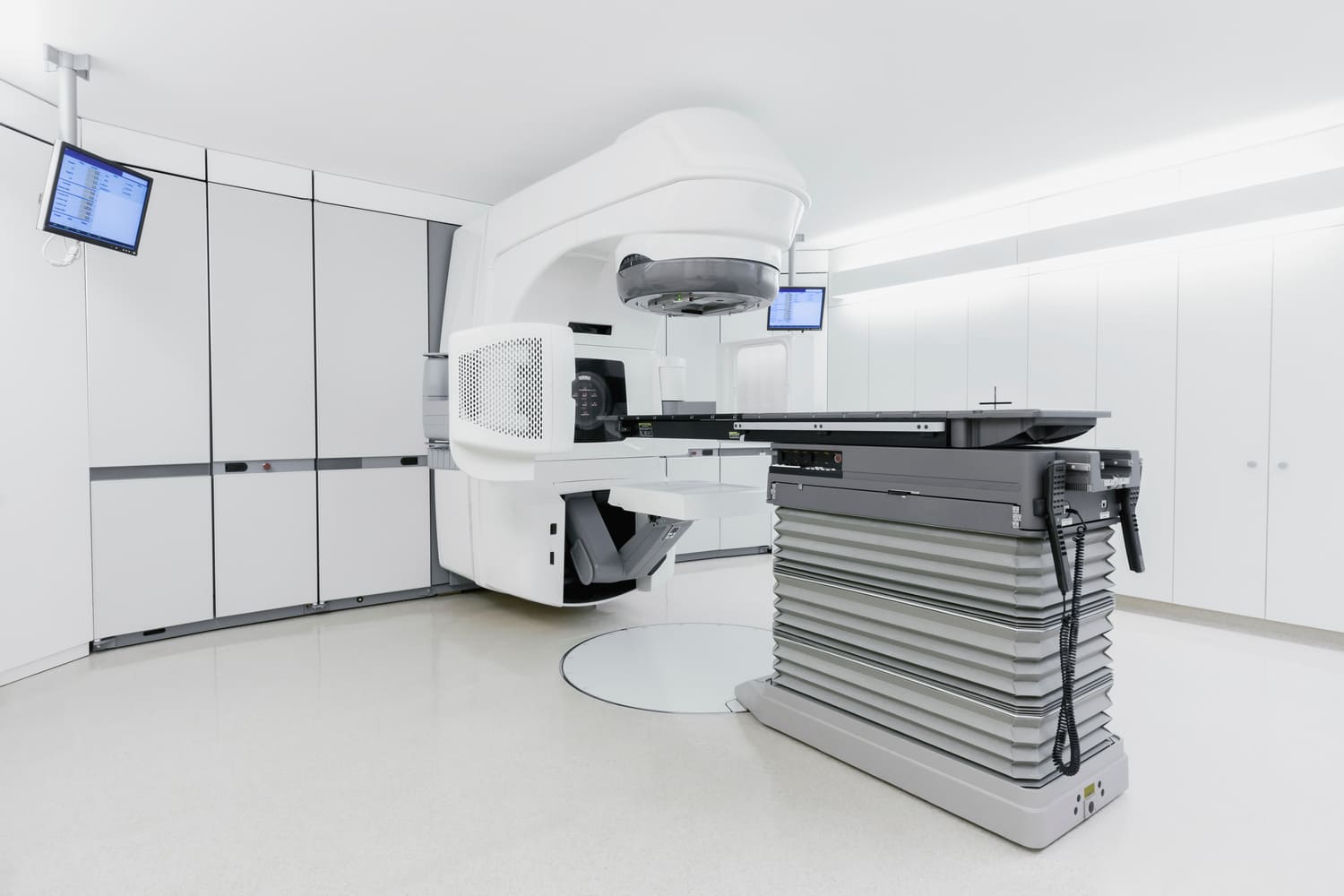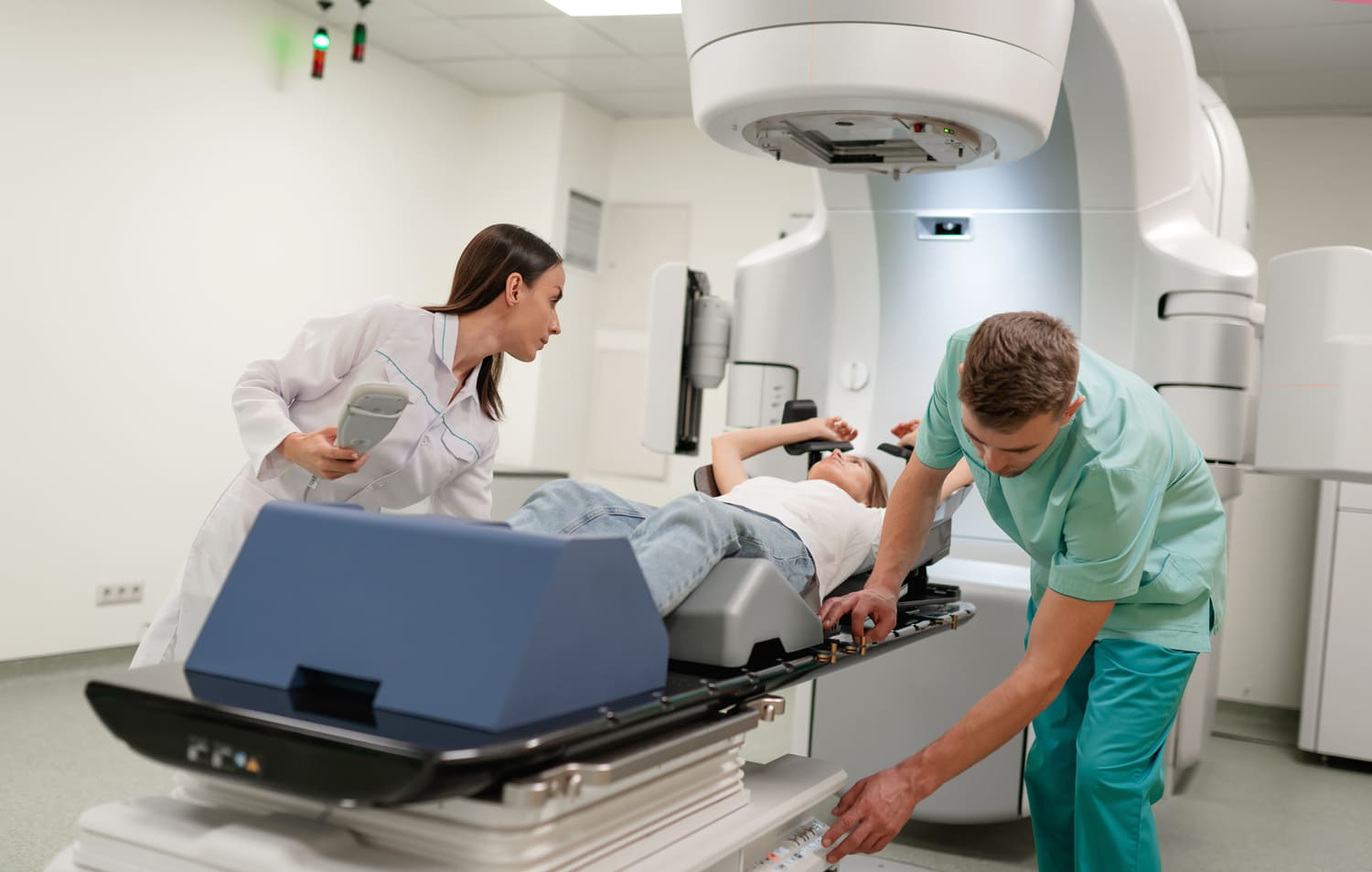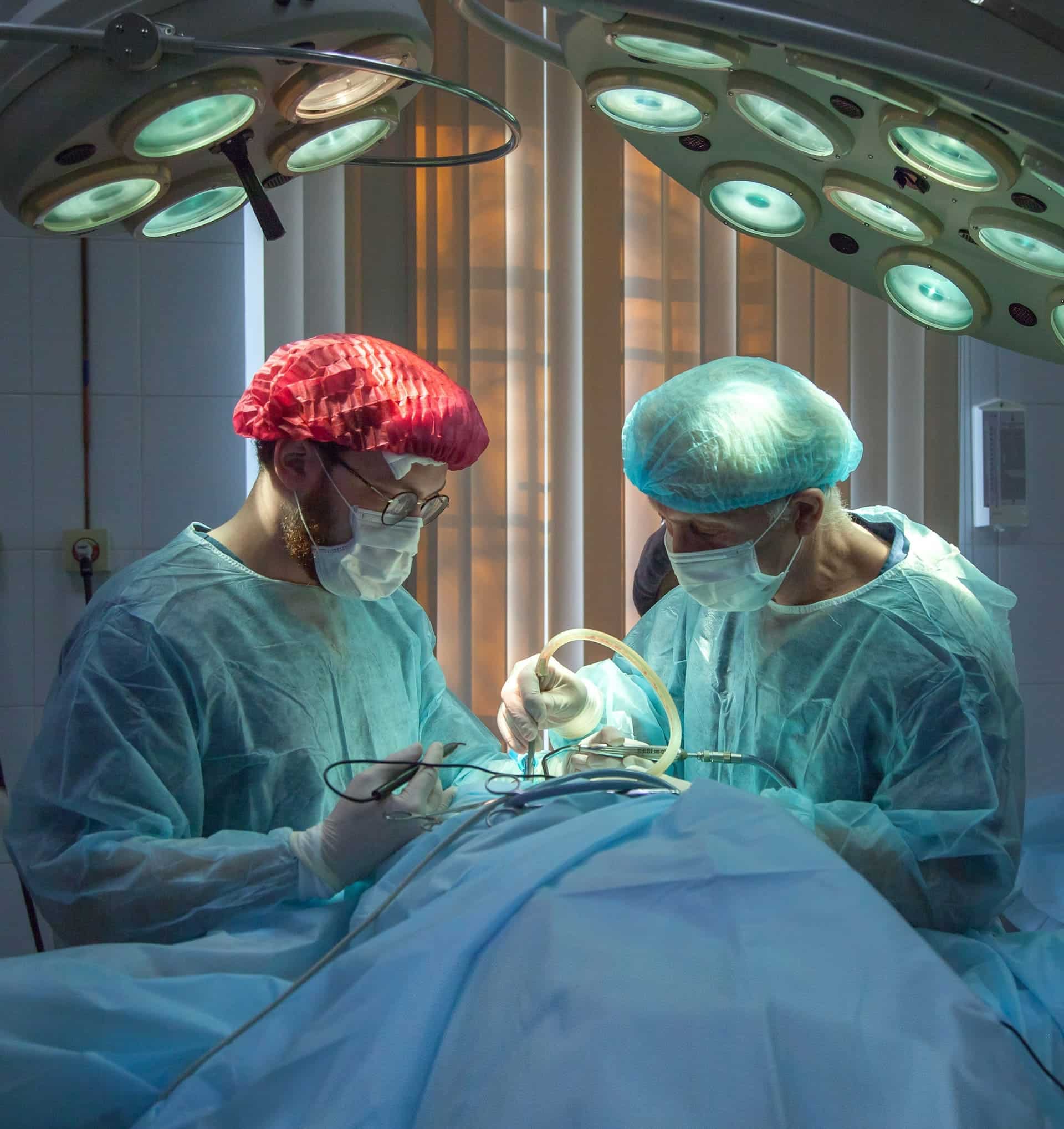
Oesophageal cancer
At WEGE Klinik, we deliver precise, personalised radiotherapy for oesophageal cancer, using advanced technology and expert planning to ensure accuracy and safety.
Patients are typically referred after a diagnostic evaluation and tumour board recommendation, often by their gastroenterologist, surgeon, or oncologist. During the initial consultation, we thoroughly review all medical records and imaging to define the most suitable radiotherapy plan. We discuss timing, technique, and possible side effects, allowing each patient to make informed decisions with confidence.
Our care combines technical excellence with a human approach—precision medicine, delivered with empathy.
*Mandatory fields
Specialists in oesophageal cancer care
Led by Prof. Dr. Michael Pinkawa, our radiotherapy team has significant experience in treating oesophageal tumours. At WEGE Klinik, treatments are delivered by an interdisciplinary team that combines clinical precision with a strong focus on patient comfort and support. Meet our team
Treatments at WEGE
For oesophageal cancer, radiotherapy plays a key role in both curative and palliative treatment, especially when surgery is not an option or when a combined approach is required. Below is an overview of the most appropriate radiotherapy treatments and techniques available at WEGE Klinik.
External beam radiotherapy (EBRT)
External beam radiotherapy is the mainstay treatment for oesophageal cancer, particularly when surgery is not possible or when a combined approach with chemotherapy is recommended.

External beam radiotherapy is the mainstay treatment for oesophageal cancer, particularly when surgery is not possible or when a combined approach with chemotherapy is recommended. It is commonly used in both curative and palliative settings to reduce tumour size, relieve symptoms such as difficulty swallowing, and improve overall outcomes.
EBRT is used in a curative setting in two different concepts. The first concept concerns operable oesophageal cancers. Operability needs to consider the volume and extensions of the individual cancer and the patient comorbidities (functional status of the organs to withstand a large operation). A preoperative radiotherapy (neoadjuvant radiotherapy) is usually combined with a weekly chemotherapy (applied on a single day in a week). It includes 23-25 fractions, with five fractions in a week, over a period of five weeks. The operation is performed after about 4-6 weeks, as tumour shrinkage takes some time.
The second curative concept is a primary radiotherapy or radiochemotherapy (without an additional operation). In some situations, as in upper (cervical) oesophageal cancer, an operation is not associated with a prognostic advantage. In other situations, patient comorbidities do not allow a large operation. The recommendation for a primary radiotherapy is decided in a multidisciplinary tumour board that includes several different specialities. A primary radiotherapy includes about 28-30 treatment fractions, with five fractions in a week, over a period of six weeks.
At WEGE Klinik, EBRT is delivered using advanced techniques that ensure high precision and optimal protection of surrounding healthy organs such as the heart, lungs, and spinal cord. Treatment is carefully planned using 3D imaging and delivered in daily sessions over several weeks, depending on the stage, location, and individual patient factors.
IMRT – Intensity-Modulated Radiotherapy
At WEGE Klinik, Intensity-Modulated Radiotherapy (IMRT) is delivered using the Elekta Versa HD linear accelerator, which allows for highly precise modulation of radiation dose. IMRT sculpts the radiation around the shape of the tumour, significantly reducing exposure to critical structures such as the heart, lungs, and spinal cord. This is particularly important for oesophageal tumours located in the upper or middle thoracic region, where proximity to vital organs increases the risk of toxicity. IMRT enables clinicians to escalate the dose to the tumour while preserving surrounding healthy tissue, improving local control and reducing side effects.
VMAT – Volumetric Modulated Arc Therapy
VMAT is an advanced evolution of IMRT that also uses the Elekta Versa HD system to deliver radiation in a continuous arc around the patient. This technique adjusts both the shape and intensity of the beam in real time, resulting in shorter treatment sessions and highly conformal dose distribution. VMAT is especially beneficial for treating large or irregularly shaped oesophageal tumours, or when lymph nodes must be included in the treatment field. The shorter delivery time improves patient comfort and is particularly well suited for frail patients or those who struggle to remain in position for extended periods.
IGRT – Image-Guided Radiotherapy
In oesophageal cancer, tumour motion due to breathing, swallowing, or digestive activity can impact treatment accuracy.

In oesophageal cancer, tumour motion due to breathing, swallowing, or digestive activity can impact treatment accuracy. WEGE Klinik uses real-time image guidance with the ExacTrac Dynamic system to monitor patient positioning and tumour location with sub-millimetre precision. This advanced system integrates surface tracking and 4D thermal imaging, ensuring that radiation is only delivered when the tumour is in the correct position. IGRT is essential for protecting surrounding organs and delivering the prescribed dose with maximum accuracy every day.
Brachytherapy
In selected cases of oesophageal cancer endoluminal brachytherapy may be used either as a second chance to cure the cancer or with the focus to relieve symptoms and improve quality of life.

In selected cases of oesophageal cancer—particularly in tumour recurrences after a previous radiotherapy or to reach a fast effect in tumours causing obstruction and difficulty in swallowing—endoluminal brachytherapy may be used either as a second chance to cure the cancer or with the focus to relieve symptoms and improve quality of life. This technique involves placing a small radioactive source directly inside the oesophagus, close to the tumour, using an intraoesophageal applicator that is similar to an endoscope.
Oesophageal brachytherapy is performed under sedation. Treatment is performed as an inpatient treatment with an overnight stay in WEGE. The total treatment includes 1-4 treatment fractions, depending on the treatment intention and previous irradiation in the sam area. A single treatment fraction has a duration of about five minutes, applying high doses to the oesophageal wall and an optimal protection of neighbouring organs due to the sharp decline of the dose with increasing distance to the radioactive source.
What is oesophageal cancer? |
Anatomy and function of the oesophagus |
How oesophageal cancer develops |
Symptoms and risk factors |
|---|---|---|---|
|
Oesophageal cancer is a disease in which abnormal cells grow uncontrollably in the tissue lining the oesophagus. These cells form a tumour that can interfere with swallowing, nutrition, and digestion.
As the tumour grows, it may obstruct the passage of food and spread to nearby structures such as lymph nodes, the windpipe, or the stomach. Early detection and treatment significantly improve the chances of controlling the disease. |
The oesophagus is a muscular tube that connects the throat (pharynx) to the stomach. It measures about 25 centimetres in length and runs behind the windpipe and heart, passing through the diaphragm before reaching the stomach.
Its main function is to carry food and liquids from the mouth to the stomach through coordinated muscle contractions called peristalsis.
The oesophagus is lined with mucosal tissue, which can give rise to different types of cancer depending on the cells affected. |
Oesophageal cancer begins when mutations occur in the cells lining the inner wall of the oesophagus. These mutations cause the cells to grow uncontrollably, eventually forming a tumour.
Over time, the tumour can grow deeper into the oesophageal wall and spread to nearby lymph nodes or distant organs. There are two main types of oesophageal cancer: squamous cell carcinoma, which usually develops in the upper or middle part of the oesophagus, and adenocarcinoma, more commonly found in the lower part near the junction with the stomach.
The type, location, and stage of the cancer guide the treatment approach. |
Oesophageal cancer may not cause noticeable symptoms in its early stages. As the disease progresses, common symptoms can include:
These symptoms often appear gradually and may be mistaken for other digestive issues, which can delay diagnosis. Risk factors include chronic acid reflux (GORD), Barrett’s oesophagus, smoking, heavy alcohol use, obesity, poor diet, family history of gastrointestinal cancers, and, in some cases, prior chest radiation |
A full course of external beam radiotherapy usually lasts between 4 and 6 weeks, with daily sessions from Monday to Friday. Each session takes around 15–30 minutes, but the actual time under the machine is just a few minutes.
Radiotherapy is painless. You won’t feel anything during the session itself. Over time, you may develop side effects like fatigue, difficulty swallowing, or irritation in the throat or chest. These are usually temporary and manageable.
You may need to adjust your diet if swallowing becomes difficult. Our team will support you with nutrition advice and, if necessary, refer you to a dietitian.
Many patients are able to carry on with light activities, work, or caring responsibilities, depending on how they feel. It’s important to rest when needed and talk to us if anything becomes too difficult.
At WEGE Klinik, you’ll have access to a team of professionals including doctors, nurses, radiation therapists, and support staff. We are here to guide you through every step of the process—medically and emotionally.
Testimonials
At WEGE Klinik, we are committed to supporting our patients and their families throughout the oseophageal cancer journey, offering expert care and understanding every step of the way.
 Gisela R., 70 – Freiburg
Gisela R., 70 – Freiburg
“My treatment was intense, but so was the support. The staff noticed small things before I even mentioned them — like changes in my energy or voice. That attention gave me confidence. It felt like being looked after by people who truly care.”
 Holger S., 68 – Kassel
Holger S., 68 – Kassel
“Before treatment, I had lost a lot of weight and energy. Eating was nearly impossible. What impressed me at WEGE Klinik was how quickly the radiotherapy helped ease the obstruction. Within a few sessions, I could eat soft foods again. That gave me a sense of progress — something I really needed at that stage.”
 Stefan M., 61 – Leipzig, Germany
Stefan M., 61 – Leipzig, Germany
“I was nervous about radiotherapy near my chest. I imagined it would be painful or frightening. But the team used advanced technology that made it very precise, and I always felt safe. Being able to go home each day and sleep in my own bed made the whole process more manageable.”
If you have general questions, you can contact us by phone or e-mail. We will then get in touch with you as soon as possible.
WEGE Klinik:
Phone: +49 228 5306 0
Email: info@wegeklinik.com
Web: www.wegeklinik.com
WEGE MVZ:
Phone: +49 228 5306 202
Email: info@wegemvz.com
Web: www.wegemvz.com